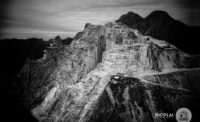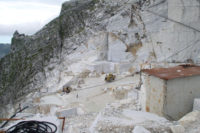Villa Bacchini, as it was originally called, was one of the few villas built in the Cervinia area since the 1930s and was destroyed in 1980 by the confluence of two avalanches. Following this event, the Valle d'Aosta Autonomous Region arranged several interventions, which offered the possibility of protecting the area and rebuilding the villa.
The owners at that time, the Bacchini family, chose not to start with the reconstruction and sold what remained of the structure to the Harrison family of London, who bought it to restore the house to its former glory. The exterior of the villa was protected and the reconstruction project -- followed by Architect Mariapia Bettiol’s Studio from Aosta in collaboration with the interior contractor Concreta from Valtellina -- necessarily had to take this aspect into account.
Engineer Bacchini -- the inventor of the famous Allocchio-Bacchini radio, which had known great success in the golden years of the radio -- had built the villa in 1936, having the materials transported on the back of a mule, as at the time only a mule track connected the building to the road system.
It was not difficult for the Harrison family to rebuild the villa as it was. The new owners were literally fascinated by the old photos reproducing its facade, as well as, the famous gardens that surrounded it. The gardens had aroused great interest among Cervinia’s visitors, including Maria Josè Savoia.
Reviving the Ancient Splendor
The Harrisons' intent was to rebuild the villa and to revive the ancient splendor that surrounded it. To date, the villa building has been finished, while the gardens are still in the process. To signify the commitment to revive this historic building and its magical garden from its ashes, the owners have renamed it La Fenice del Monte Cervino (The Phoenix of the Matterhorn). Their prior commitment was to respect the concept of the old chalet, while giving a high level of comfort using quality materials, entering the category of luxury chalets in the Alpine area. The intention was to have a place to live, but also a location to rent to guests, which is why the villa was designed to be self-sufficient. In fact, inside the structure you can find the classic “residential” functions, such as the bedrooms, the living room, the dining room and the kitchen alongside more proper “hotel” amenities, such as an indoor swimming pool, a spa, a cinema room, a gym, a ski room and a bike room. A staff is available inside to assist guests.
The Structure of the Villa
The building extends over 1,200 square meters on six levels, including the basement, where the technical rooms are located. Seven double rooms have been created, as well as a larger living room and a more reserved one, a kitchen that can also be used by guests, a dining room and a buffet area.
The design concept by Architect Bettiol and her team is based on the use of stone and exposed wood as a tradition in the mountains, but at the same time combining rustic old wood and stone with rich and modern materials like velvets and crystals. This modern combination is complemented by a neoclassical touch. The Harrison family loves the notes of Italian Neoclassicism and wanted to recall them with decorations and elements inside their chalet. The central atrium, where the elevator shaft opens, features a parapet in metal and brass with neoclassical motifs, while in the common areas the large wooden frames outlining the walls combine with the stuccoes and plaster decorations recalling the taste and aesthetics of classicism.
The stone originally used in the construction of the villa in the 1930s could be partially reused and integrated with local stone for the external façade. Everything was laid dry, with no joints in sight, thus giving additional value to the construction.
La Fenice can only be accessed by off-road vehicles from the avalanche protection valley or from a private farm road. Guests are picked up by SUV or snowmobiles and arrive directly in the garage, where there is a reception area and an underground wine cellar to make the most of this access.
The villa is unique with nothing surrounding it. The structure stands majestically against a rocky wall framed by the Grandes Murailles. The intervention was much appreciated by the community of Cervinia because it brought back to life a structure that for almost half a century had been part of the architectural identity of the place and that could have been lost forever.
.jpg?t=1643360484&width=1080)
.jpg?t=1643360502&width=1080)
.jpg?t=1643360522&width=1080)
.jpg?t=1643360541&width=1080)
.jpg?t=1643360563&width=1080)


